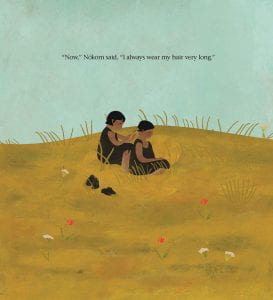Written by David A. Robertson
Illustrated by Julie Flett
Reviewed by Lindsey Smith
Why does the child’s grandmother wear such colorful clothes? Why is her hair so long? Why does she spend so much time with her brother? Why does she sometimes speak Cree?
In this simple yet haunting dialogue between a child and grandmother, the reader learns about the violent history of Canada’s residential schools. The grandmother answers the child’s questions with direct descriptions of life in the schools that always begin, “When I was your age…” But after each description, on the next page, the grandmother tells her child how she and the other captured children subverted the racism and oppression of the residential schools by stealing moments of joy when they were alone. The moments of joy are simple: holding hands with a sibling, rolling in a pile of leaves, whispering with a friend. In this way, When We Were Alone isn’t falsely cheery, but it skillfully highlights the resilience that children exhibited in residential schools without ignoring the damage that the schools have caused.
Like much of Julie Flett’s work, these illustrations are beautiful yet slightly stark. They fit the tone of the book perfectly. Just look at the image of two Cree children braiding their hair in a field below. Julie Flett is a Cree-Métis illustrator who has illustrated many beautiful books. David A. Robertson is Swampy Cree as well.

When We Were Alone is a historical fiction picture book, and therefore would fit well into a conversation about Native American genocide. It’s unusually adaptable to a variety of age groups, but teachers should be sure that they’re well informed on the topic before reading and that they’re ready to answer any challenging questions. Preschoolers can use it to talk about the basic facts of the history of residential and boarding schools, and fifth graders can use the same book to have a more in-depth conversation about what happens and continues to happen to Indigenous child and how they find ways to fight back.

Lindsey, this is such a well written review. This book does seem really adaptable to different grade levels, and I love the idea of 5th graders using the book as in-depth study of Native American genocide. This would fit well into a unit about action.
oooo good point about the unit about action!